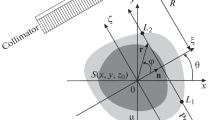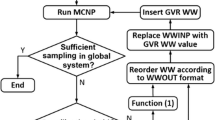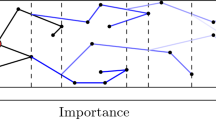Abstract
A numerical radiation transport methodology for predicting gamma emission tomographs was developed utilizing the deterministic fuel burn-up software, ORIGEN, in the SCALE code package as a source definition input for Monte Carlo N Particle Transport ver. 6.1 to simulate gamma emission spectra from irradiated nuclear fuel and measured by an inorganic scintillator detector. Variance reduction utilized analytical expressions for the solid angle and field of view between source, collimator and detector to normalize the gamma energy spectrum from a non-analog monodirectionally biased beam source problem to approximate the equivalent analog problem of an isotropic source. One normalization scheme, which assumes that the source is distributed in a thin cylindrical volume, can achieve lower than 6% error and an order of 107 reduction in the computational cost. A different normalization scheme involving a truncated cone source distribution overestimated the count rate by approximately 45% but had similar computational savings. In both approaches, the accuracy and computational savings of the method improves with increasing collimator aspect ratio. This method is therefore useful for problems with high aspect ratio collimators.






Similar content being viewed by others
Change history
27 February 2020
In the original article, Equation 4 was incorrectly published. The correct equation is provided in this correction
References
X-Ray Mass Attenuation Coefficients—water, liquid, NIST. https://physics.nist.gov/PhysRefData/XrayMassCoef/ComTab/water.html. Accessed 15 July 2018
Jacobsson S, Bäcklin A, Håkansson A, Jansson P (2000) A tomographic method for experimental verification of the integrity of spent nuclear fuel. Appl Radiat Isot 53:681–689
Jacobsson S, Håkansson A, Jansson P, Bäcklin A (2001) A tomographic method for verification of the integrity of spent nuclear fuel assemblies—II: experimental investigation. Nucl Technol 135:146–153
Jacobsson S, Håkansson A, Bäcklin A, Jansson P, Osifo O, Willman C (2006) Tomography for partial-defect verification: experiences from measurements using different devices. ESARDA Bull 33:15–25
Lundqvist T, Jacobsson S, Håkansson A (2007) SPECT imaging as a tool to prevent proliferation of nuclear weapons. Nucl Instrum Methods A 580:843–847
Jacobsson S, Lundqvist T, Håkansson A (2008) Verification of completeness of spent nuclear fuel assemblies by means of tomography. PHYSOR 08(4):3131–3137
Parker H, Joyce M (2015) The use of ionising radiation to image nuclear fuel: a review. Prog Nucl Energy 85:297–318
Jansson P, Svärd S, Håkansson A, Bäcklin A (2006) A device for nondestructive experimental determination of the power distribution in a nuclear fuel assembly. Nucl Sci Eng 152:76–86
Andersson P, Holcombe S (2017) A computerized method (UPPREC) for quantitative analysis of irradiated nuclear fuel assemblies with gamma emission tomography at the Halden reactor. Ann Nucl Energy 110:88–97
Holcombe S, Jacobsson S, Hallstadius L (2015) A Novel gamma emission tomography instrument for enhanced fuel characterization capabilities within the OECD Halden Reactor Project. Ann Nucl Energy 85:837–845
Lanthanum Bromide Scintillation Detectors, Ortec-online.com (2017) http://www.ortec-online.com/-/media/ametekortec/brochures/lanthanum.pdf. Accessed 15 Dec 2017
Kawrakow I, Fippel M (2000) Investigation of variance reduction techniques for Monte Carlo photon dose calculation using XVMC. Phys Med Bio 45:2163–2183
Rearden B, Jessee M (2016) SCALE Code System
Goorley T et al (2012) Initial MCNP6 release overview. Nucl Technol 180:298–315
Nilsson J (2010) Using the LaBr3:Ce scintillation detector for mobile γ-spectrometry. http://lup.lub.lu.se/luur/download?func=downloadFile&recordOId=2157130&fileOId=2157384. Accessed 17 Feb 2018
Acknowledgements
This material is based upon work supported by the U.S. Department of Energy, Nuclear Energy University Programs, Project 17-13011, and by the U.S. Nuclear Regulatory Commission, Nuclear Education Program under Award NRC-HQ-13-G-38-0026.
Author information
Authors and Affiliations
Corresponding author
Additional information
Publisher's Note
Springer Nature remains neutral with regard to jurisdictional claims in published maps and institutional affiliations.
Rights and permissions
About this article
Cite this article
Kilby, S., Jin, Z., Avachat, A. et al. A source biasing and variance reduction technique for Monte Carlo radiation transport modeling of emission tomography problems. J Radioanal Nucl Chem 320, 37–45 (2019). https://doi.org/10.1007/s10967-019-06457-1
Received:
Published:
Issue Date:
DOI: https://doi.org/10.1007/s10967-019-06457-1




